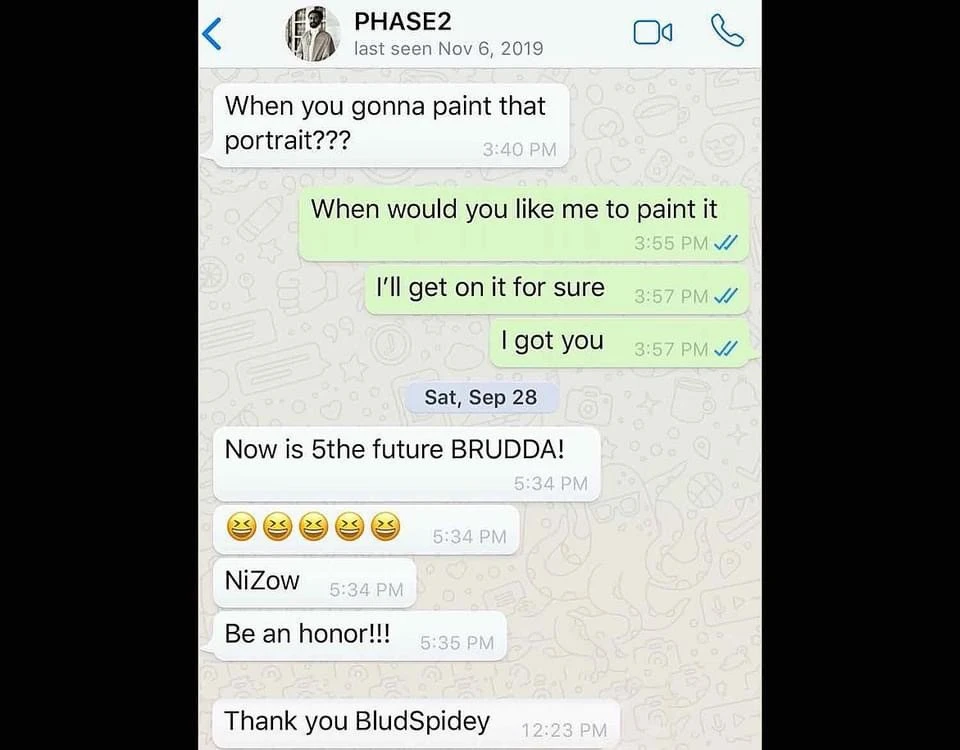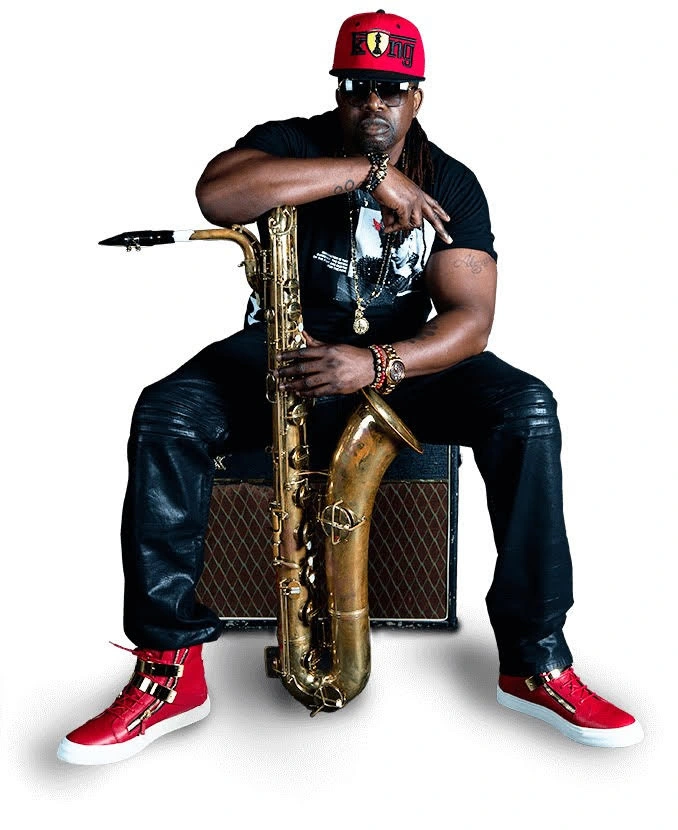Your cart is currently empty!
Chor Boogie, a.k.a. Joaquin Lamar Hailey is an internationally renowned spray paint artist celebrated for his groundbreaking technical mastery and emotional depth in the medium. Dubbed ” the color shaman,” he uses color as a form of therapy and visual medicine. His visionary murals and exhibitions have been showcased globally, from the Smithsonian to the Beijing Olympic Games.
A self-taught artist inspired by both classical masters and street art pioneers, Chor addresses issues of social justice, healing, and cultural heritage through his dynamic art.
A close friend of pioneering aerosol art and street artist, the late Phase 2, Chor Boogie, donated the portrait ”PHASE2LIVESFOREVER” to The Hip Hop Museum, a piece requested explicitly by his late friend Phase 2.
The Hip Hop Museum caught up with Chor Boogie to talk about Phase 2, the word graffiti, and one of his most memorable moments with Wu-Tang.
Adam Aziz: You donated the piece ‘PHASE2LIVESFOREVER’ to The Hip Hop Museum. Can you tell me the story behind the late Phase 2 asking you to create that?
Chor Boogie: Me and Phase go way back. Before he died, I had known him for close to 20 years. He was always wanting me to do his portrait. Since we met, he always tried to get me to do it. I was introduced to Phase through Vulcan and then introduced to Riff 1-7-0 through Phase, and I had this project in mind. I always wanted to paint my brethren in arms but never got around to it. I guess it took a little twist and turn of tragedy with what happened to Phase to get me to do it. When he originally asked me to do it, he gave me a photo which is the photo I painted. He gave me that photo maybe 10 years before I painted it, and he was like, I want you to paint this photo. I thought it was the right time to do it when he passed.
AA: Did you speak with him about it before he passed?
CB: I didn’t even know he was on his deathbed. Only a select few knew. I think it was COCO 144 and RIFF 170. They were the only ones who knew he was in the hospital. Phase was texting me from the hospital, and I was trying to talk to him. I was wondering why he wasn’t responding to me. And I was wondering why he wasn’t hopping on the phone. I didn’t know that he couldn’t speak in his situation. He couldn’t talk because of Lou Gehrig’s disease and could only write. He didn’t want to tell anybody that he was sick. He brought up the portrait, and I was like, alright, man, I’ll do it. Then he threw off a little hint about how he wasn’t going to be around and said I better get to it because I guess he wanted to see it before something happened. I didn’t know what he was talking about. And then I got a call that he died, and it all made sense.

AA: What about Phase’s style of street art stood out to you?
CB: That guy is why I started painting when I was 13 years old. I’m 45 now. I’ve been doing this for 30 years, maybe a little over. But he was the first one that I’ve really seen his style. He may have had some interviews in The Source and VIBE. I was like, wow, this guy is phenomenal. This is next level. Nobody is doing it like this in the game. And I’m like, I want to be like that dude, but in a different way, because I do more imagery, more characters. I call it modern hieroglyphics.
Because we don’t use the G word. We don’t use the word graffiti. We don’t use it.
AA: Talk to me more about that. Why don’t you use the word graffiti?
CB: Because this is a culture that was started by Blacks and Latinos back in the day. And to see a system that took a creative force that influenced the world, that was created, that was created in New York City, created on the streets. By underprivileged people who didn’t have any money, they made it; they made their own way. And to have a system coin it with the negative connotation and just put these negative connotations around that art form didn’t make any sense. They made money off of it and all types of stuff, man. They manipulated and took advantage of it. When in reality it’s the aerosol art culture. This is spray cans, spray paint.
AA: So the word street art is a replacement for…
CB: I think street art is its own category, but it’s not just street art but also aerosol art. Street art can be any medium. We are the original art from the streets. But graffiti was a word that was Phase’s pet peeve. He hated that word.
AA: Many people have commissioned your work. Does any one specific piece stand out?
CB: One of the greatest things was doing Ol’ Dirty Bastard’s portrait when he died. Rock The Bells commissioned it. We ended up bringing it up on stage with Wu-Tang. It was the craziest moment of my life. Wu-Tang is my shit right there. I did Ol’ Dirty’s portrait live. I finished at 10 p.m., and Wu was supposed to go on at 10. They don’t go until midnight. We’re waiting around with this painting, and ODB’s mom comes and sees the painting. She’s blown away, saying, “Oh, that’s my baby Russell.” She was loving it. We carried the portrait on stage, and the painting is facing the crowd. That crowd was so alive when they saw that painting. We set it up against the DJ booth and stayed on stage while they were performing.
The show goes off, and RZA goes out there and stops things in the middle of the show and introduces Ol’ Dirty’s mom, Cherry, to the crowd. The first thing that comes out of her mouth is I would like to thank the artist who painted my baby Russell. She turns around and looks at me, telling me to come out. I’m like a deer stuck in headlights. My boy with me pushes me to the middle of the stage. All of a sudden, we break into singing “Shimmy Shimmy Ya”, and I’m out there singing it with Wu-Tang.
AA: Why do you think street art or graffiti doesn’t get the respect it deserves the same way other elements of Hip Hop culture do?
CB: Because of graffiti and its illegal aspect. It was an outlet for people to express themselves, but it caused damage simultaneously, giving it its negative connotation. And then anybody associated with a spray can who doesn’t even do that gets associated with it. I won’t say I didn’t partake in it because I did. I grew out of it because I’m a fucking grown-ass man, and I was more respected. I respected the art more, and appreciated the art more because I’ve been an artist since I was five years old. I stuck with the art part of it. I can honestly say that I was probably one of the pioneers who helped bring this culture or art form to another level when it comes to taking it to museums and galleries.
AA: Why was it so important for you to donate this piece to The Hip Hop Museum?
CB: I was working on getting it into the Smithsonian because they have a portrait gallery. I was talking to people over there, and somebody dropped the ball. Because Phase would have been perfect in that Museum. As time passed, I knew we needed to get this painting somewhere. Then I heard about The Hip Hop Museum. I connected with Pete Nice and told him about the portrait. It has to be in The Hip Hop Museum. Phase was the one that helped pioneer this art form around the world. This man inspired the world.
Follow Chor Boogie on Instagram.
Read more interview on The Hip Hop Museum!



